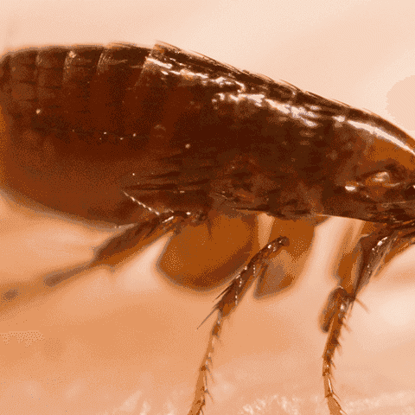
Fleas

About
What are fleas?
Fleas are vector pests that are notorious for feeding on household pets. However, they also pose a threat to humans. To get you started in your flea detection efforts, here are some major identifying features of fleas in your home:
- These tiny insects are flat and flightless.
- They measure about 1/8 of an inch long.
- They use their biting mouthparts to pierce their hosts’ skin.
- They prefer hairy hosts, making it easier to attach to them.
- They are dark reddish-brown.
- They have three pairs of powerful jumping legs.
Are fleas dangerous?
When it comes to the dangers of fleas, there are serious consequences to consider. Household pets like cats and dogs are known for their reaction to fleas, their allergy to these parasites causing scabs and fur loss. Fleas transmit tapeworm to pets, and their saliva can cause severe allergies in our beloved cats and dogs. As a pet owner, it’s very important to take the proper precautions in your efforts to reduce your exposure to fleas.
However, humans are also at risk for flea bites. Flea bites can cause discomfort, but more importantly, fleas can transmit diseases to their hosts and cause a long list of adverse health effects. They are capable of spreading a variety of bacterial diseases and vector illnesses. Some of the vector-borne illnesses that can result from fleas include:
- Bacterial disease
- Bartonellosis (“cat scratch disease”)
- Flea allergic dermatitis (FAD)
- Parasites
- Plague
- Rickettsiosis
- Spotted fever
- Tapeworm
- Tularemia
- Typhus
What do fleas eat?
Fleas are external parasites of mammals and birds. They are vector pests that depend on blood meals to survive. While fleas feed on the blood of their host, be it human or animal, they are capable of surviving long periods without food. In fact, they can go over 100 days without feeding.
How do I know if I have a flea problem?
Fleas are hard to see because of their size. They usually hide in tall grass, wooded paths, and densely vegetated areas like leaf piles and shrubbery. They hide in yard debris, dirt, grass, weeds, and bushes, waiting for wildlife hosts to pass by so they can latch onto them.
How can I protect my property from fleas?
A flea problem can be hard to control because flea eggs are tiny and can fall anywhere. Their eggs are often found around the yard or in blankets and bedding. They reproduce very quickly, spreading their populations until there is a full-blown infestation to deal with. That’s why being proactive in your home pest control efforts is the best way to go.
Here are some preventive measures you can take to avoid fleas:
- Check everyone (including pets) for any fleas after being outside.
- Clear away yard debris and keep lawn and vegetation well-trimmed.
- Clear clutter and vacuum carpets, floors, furniture, and crevices where fleas can hide.
- Deter wildlife hosts from your yard.
- If you do have pets, treat them with a flea and tick bath or spray.
- Maintain a clean home in general, as proper sanitation is key when it comes to any pest control.
- Place flea traps on the floor to monitor flea activity within your home.
- Regularly wash all bedding, linens, laundry, and upholstery on high heat.
- Shower promptly after spending time outdoors.
- Stay out of tall grass, brush, and wooded areas.
- Steam clean carpets, curtains, and upholstered furniture.
- Treat your clothing with or buy clothing pre-treated with permethrin.
- Tumble dry your clothing on high heat for ten minutes to kill off any fleas.
- Use outdoor flea repellent on the exterior of your home to reduce the chances of infestation.
- Vacuum up eggs and larvae and properly dispose of the vacuum bag in a sealed trash can.
- Walk in the center of trails when walking, hiking, running, etc.
If, despite your efforts to keep fleas away from your property and out of your home, contact All State Pest Control for Nassau County pest control.